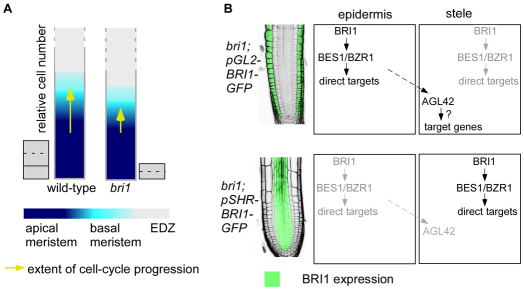Fig. 7.
Model for BR-mediated control of root meristem size. (A) Reaching a critical cell size is an essential requirement for cell cycle progression, and BRs positively affect both processes. In bri1, cells fail to expand normally and have impaired cell cycle activity. These defects probably impinge on their ability to enter the mitotic phase and delay their progression from the apical to the basal meristem. This is further reflected in the relative number of cells in the two zones (represented by the colored columns). Cells are represented by gray boxes and cytokinesis by dashed lines. (B) BR signaling in the epidermis is sufficient to control root meristem size, whereas BR signaling in the inner cell files (i.e. stele) is not. This indicates that the inner cells must receive instructive signal(s) initiated by BRI1 exclusively in the epidermis. The MADS-BOX gene AGL42 is a target of such a signal. The signal from the epidermis to the inner cells is transmitted by a different component from BES1 and BZR1, which regulate their direct target genes (i.e. BR-biosynthesis genes) locally in cells that express BRI1.

